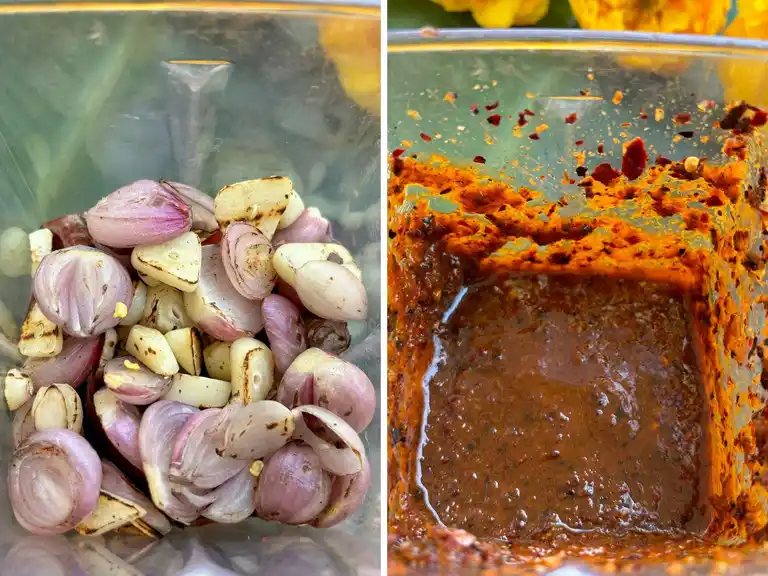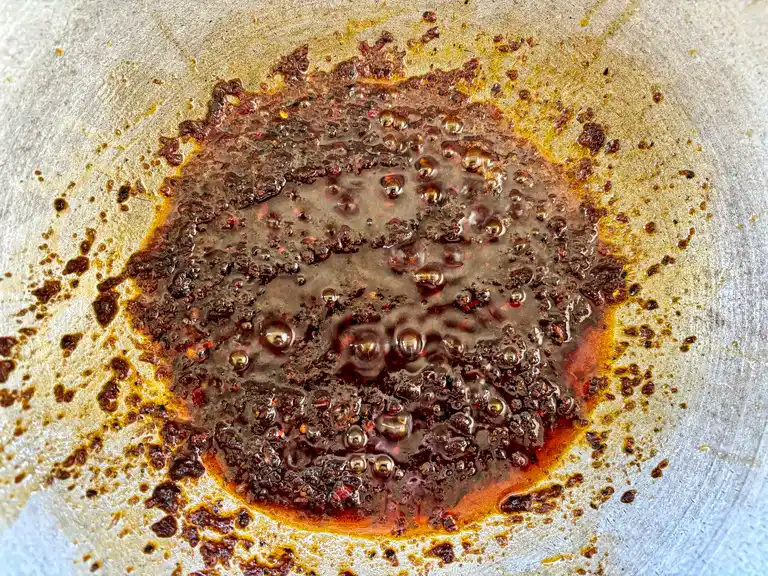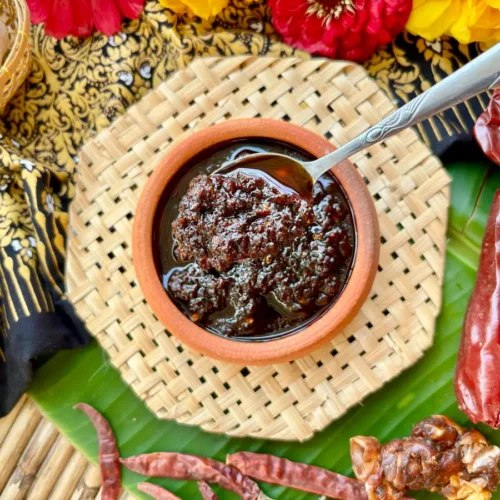Spicy | Thai Ingredients
ByPraew
This post may contain links to affiliate websites, such as Amazon, and I receive an affiliate commission for any purchases made by you using these links. I appreciate your support!
Jump to Recipe Print Recipe
Thai chili paste recipe (nam prik pao) is the perfect addition to any dish that needs a spicy kick. It’s made with traditional ingredients like shrimp paste and palm sugar, and it comes out incredibly aromatic and super yummy!

After making this Thai chili peppers paste, try one of my other related recipes: Tom yum paste, Thai red curry paste, and jeow bong.
Thai chili paste is a staple in Thai cuisine, blending spicy chilies with garlic and other seasonings. It’s essential in authentic Thai cooking for adding heath and depth to dishes like stir-fries, soups, and marinades.What is Thai chili paste
Nam prik pao
This spicy condiment is made from a delicious combination of dried chilies, garlic, and shallots which are grounded into a paste using a mortar and pestle. Fish sauce, shrimp paste, palm sugar, and tamarind paste are added for a touch of sweetness, sourness, umami, and saltiness, which balances out the spicy flavors of the chilies.
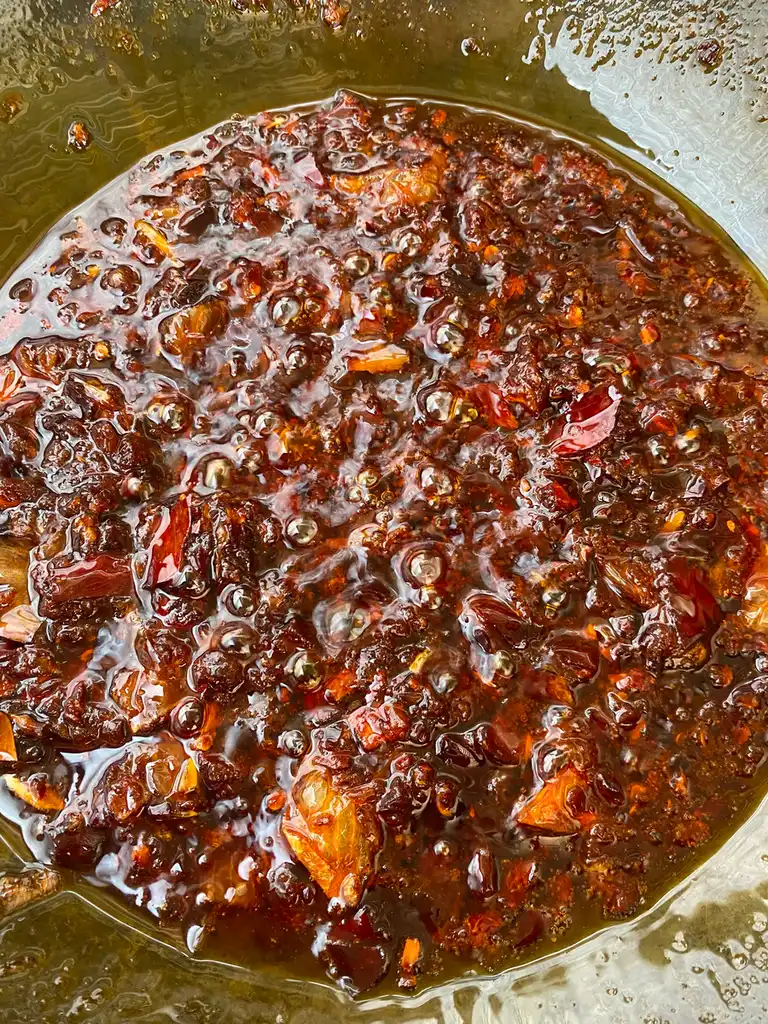
You can use the chili paste whenever you’re in the mood for some Thai cooking. Use it in stir-fries like gai pad med mamuang (Thai chicken cashew), tom yum soup, as a salad dressing, as a dipping sauce for Thai grilled pork, or simply pour it over your steamed rice.
Whatever you use this addictive paste with, it will add heat, umami and a depth of flavor to your food.
Recipe Variations
Thai chili paste can be made in many different ways. Variations in the ingredients and flavors are common in different Thai households and even in different regions of Thailand.
Family recipes in Thailand have been passed down for many generations, and each generation might have added their own unique twist to it. This goes for other Thai recipes as well. For example, my mother is a fan of using MSG in her food, but since I prefer to keep things healthy and pure, I look for other ways to achieve the same results flavorwise.

Additionally, people from Northern Thailand and Southern Thailand might add different ingredients to their nam prik pao to make milder versions or spicier versions.
For my recipe, I turned to my grandmother, and we decided to keep things traditional and simple. This Thai chili paste recipe is easy to make at home.
Why make Thai chili jam yourself
Store-bought chili paste (or Thai chili jam) is easy, but making homemade Thai chili paste has many benefits:
Customizable: You can customize the heat level to your own spice level. You get to experiment with different flavors and adjust them to your taste preference.
More flavor: Frying the garlic, shallots, and dried chilies adds an extra smoky flavor.
Rewarding: Cooking from scratch always tastes so much better, and it’s much more rewarding, right?
Healthier: Store-bought versions contain preservatives and additives we don’t need.
Cheaper: You can store it in your refrigerator for a long time, and you can save money by making it in bulk.
Authentic: And finally, I’d love for you to try our Thai culinary traditions. Thank you for showing an interest in our kitchen and our culture.
Ingredients
Ingredients can be sourced at Asian grocery stores and Asian markets.
The exact measurements are in the recipe card at the end of this post.
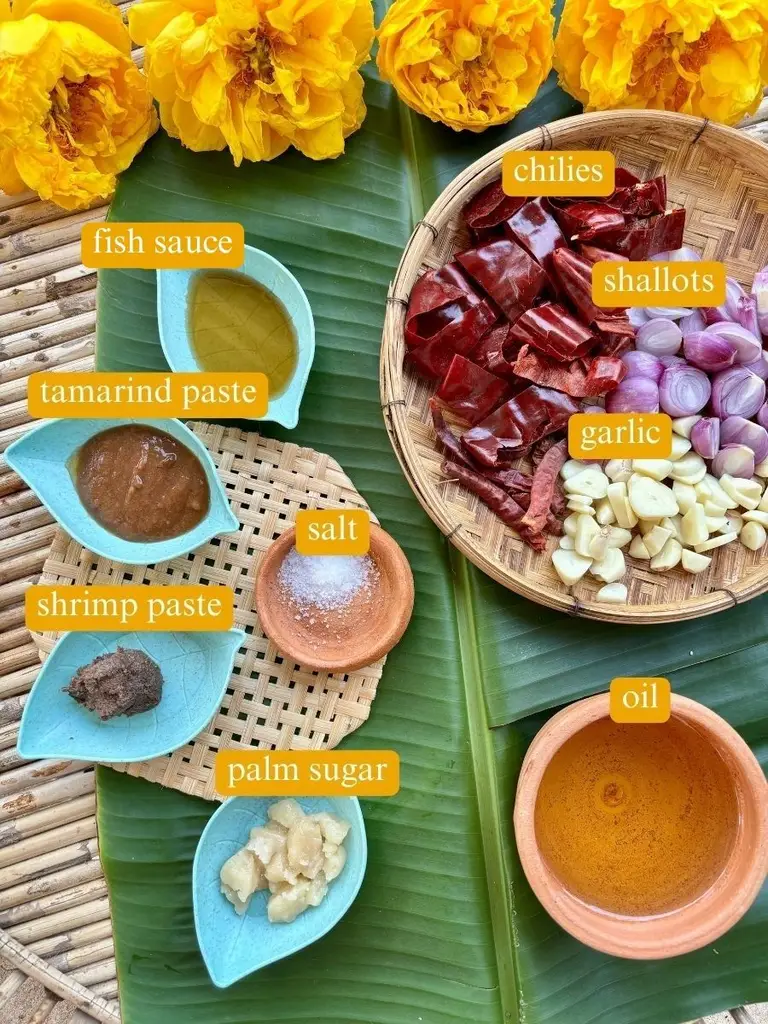
- Garlic – Garlic is a key ingredient for the pungent taste. The strong flavor of using a whole head of garlic perfectly balances out the other flavors.
- Shallots – Shallots are used for improving the texture of our chili paste, as well as adding more flavor.
- Dried chilies – Another key ingredient in nam prik pao. Dried chilies are hotter than fresh chilies and more flavorful. Opt for dry red spur chilies, these are large Thai chilies and are available at Asian grocery stores and Asian markets.
- Large dried chilies – I like to use a combo of regular and large dried chilies. These large dried chilies add a smoky, slightly sweet flavor to the condiment.
- Shrimp paste – This condiment is made from mixing fermented shrimp with salt and then leaving it out in the sun. The shrimp paste can be used to add depth and umami to dishes. Don’t be afraid to experiment with shrimp paste, it can really elevate your food.
- Fish sauce – This salty and savory sauce is commonly used in Thai cuisine for its salty flavor.
- Palm sugar – The sweetness of palm sugar balances out the spiciness of the chilies and brings a subtle sweet flavor to this homemade Thai chili paste recipe.
- Tamarind paste – Tamarind paste adds a tangy flavor and with it, we find 4 flavors of Thai cuisine in this Thai chili paste: spicy, sour, salty, and sweet.
- Salt – Enhances the overall flavors of the paste.
- Oil – Use a neutral oil with high smoke point and neutral flavor, like canola oil or vegetable oil.
Cooking instructions
Step 1: Grill sliced chilies, garlic, and shallots, turning them occasionally, until they are charred.
Step 2: In a food processor, combine all your ingredients at once. Pulse until the mixture forms a smooth paste.
Step 3: Transfer the mixture to a pan. Simmer the paste over low-medium heat, stirring occasionally. Cook for approx 2 minutes, until the oil begins to separate from the paste. Enjoy!
Kitchen tools
- Thai mortar and pestle or food processor: I have tested pounding the paste by hand and mixing with a food processor. The texture of the paste was a lot smoother and better with the food processor. While I usually advise using a mortar and pestle, for this Thai chili paste I advise a food processor.
- Cutting board and sharp knife
- Measuring spoons and cups
- Grilling pan and wok
How to use
Add a spoonful to your favorite Thai food, like Thai vegetable stir-fry. Use it as a marinade for meats or fish. Spice up your soups like this tom yum talay. Use it to make dipping sauces. Stir it into your favorite Thai fried rice. Use it as a dipping sauce for. A little goes a long way!
How to store
Always keep your hot chili paste in an airtight container to prevent it from drying out. For long-term storage, place the airtight container in the refrigerator. Use a clean spoon every time you scoop out the paste.
Freezing: For extended storage, you can freeze Thai chili paste. Portion it into ice cube trays, freeze, and then transfer the cubes into a freezer bag. This way, you can use individual portions as needed.
Frequently asked questions
How to make Thai chili paste?
Traditionally, we start with frying the shallots, garlic, and dried chilies. Then, these ingredients are pounded in a mortar and pestle. After that, palm sugar, fish sauce, shrimp paste, and tamarind paste are fried in a pan after which the pounded mixture is added. The result is a homemade Thai chili paste.
Is Thai chili paste spicy?
Yes, Thai chili paste is quite spicy and is typically used to add flavor and heat to dishes.
How long does Thai chili paste last?
When stored in an airtight container in the refrigerator, homemade Thai chili paste can last for up to one month.
Is this recipe gluten-free?
Yes, but make sure to double-check the labeling of your store-bought sauces.
Related Thai recipes you’ll love
- Thai panang curry paste
- Massaman curry paste
- Thai green curry paste
- Sen yai noodles recipe
- Thai sweet chili sauce
- Thai basil pesto
- Thai chili oil
Loved reading this Thai chili paste recipe? Please make my day by dropping a star rating and/or a comment below! Follow me onFacebook,Instagram, andPinterest.
Thai Chili Paste Recipe (Nam Prik Pao)
An easy-to-make homemade version of Thai chili paste, with traditional ingredients and an authentic way of cooking.
Praew
Prep Time 5 minutes minutes
Cook Time 25 minutes minutes
Total Time 30 minutes minutes
Cuisine Thai
Course Ingredients
Serving Size 6 people
Ingredients
- 1.05 ounce garlic chopped
- 2.1 ounces shallots thinly sliced
- 0.5 ounces large dried chilies chopped, see notes
- 6 dried chilies
- 1/2 tablespoon shrimp paste
- 1/2 tablespoon fish sauce
- 1 tablespoon palm sugar chop to measure
- 1 tablespoon tamarind paste
- 1/2 cup oil
- 1/2 teaspoon salt
Instructions
Grill sliced chilies, garlic, and shallots, turning them occasionally, until they are charred.
In a food processor, combine all your ingredients at once. Pulse until the mixture forms a smooth paste.
Transfer the mixture to a pan. Simmer the paste over low-medium heat, stirring occasionally. Cook for approx 2 minutes, until the oil begins to separate from the paste. Enjoy!
Notes
- Use the nutrition card in this recipe as a guideline.
- Chilies: Dry red spur chilies are large Thai chilies that are mild in heat but add lots of chili flavor. You can get them at Asian grocery stores and Asian markets.

